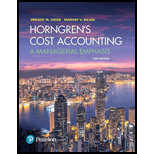
Concept explainers
FIFO method (continuation of 17-41).
- 1. Complete Problem 17-41 using the FIFO method of
process costing .
Required
- 2. If you did Problem 17-41, explain any difference between the cost of work completed and transferred out and the cost of ending work in process in the assembly department under the weighted-average method and the FIFO method. Should McKnight’s managers choose the weighted-average method or the FIFO method? Explain briefly.
17-41 Weighted-average method. McKnight Handcraft is a manufacturer of picture frames for large retailers. Every picture frame passes through two departments: the assembly department and the finishing department. This problem focuses on the assembly department. The process-costing system at McKnight has a single direct-cost category (direct materials) and a single indirect-cost category (conversion costs). Direct materials are added when the assembly department process is 10% complete. Conversion costs are added evenly during the assembly department’s process.
McKnight uses the weighted-average method of process costing. Consider the following data for the assembly department in April 2017:

a Degree of completion: direct materials, 100%; conversion costs, 40%.
b Degree of completion: direct materials, 100%; conversion costs, 15%.
- 1. Summarize the total assembly department costs for April 2017, and assign them to units completed (and transferred out) and to units in ending work in process.
Required
- 2. What issues should a manager focus on when reviewing the equivalent units calculation?
Want to see the full answer?
Check out a sample textbook solution
Chapter 17 Solutions
Horngren's Cost Accounting, Student Value Edition Plus MyLab Accounting with Pearson eText - Access Card Package (16th Edition)
- Principles of Accounting Volume 2AccountingISBN:9781947172609Author:OpenStaxPublisher:OpenStax College
